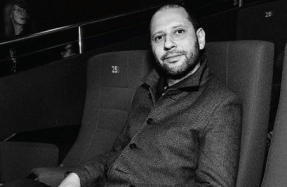FEEL THE LOVE

AT THE END OF SPIKE LEE’S DO THE RIGHT THING, after the murder of Radio Raheem (Bill Nunn) by the police and the fire that destroys Sal’s Pizzeria, we see morning return to the neighborhood through the eyes of its elders, Da Mayor and Mother Sister, whose roles in the film depend on audiences’ intimate familiarity with the actors playing them: Ossie Davis and Ruby Dee. The conclusion finds them in Mother Sister’s bedroom where Da Mayor wakes up: “Hope the neighborhood is still standing,” he says; “we’re still standing,” she replies. They move toward the window, which frames them as they peer out, surveying the wounded block, as the camera spins to Mookie (Spike Lee) below.
So powerful is the symbolic presence of Dee and Davis in Do the Right Thing that their performances almost demand to be read allegorically. And they have been, since the film’s 1989 release: reviewing in The New York Times, Vincent Canby wrote that Dee and Davis “preside over it, as if ushering in a new era of black filmmaking.” When their shared archive was acquired by the Schomburg Center for Research in Black Culture last year, Jennifer Schuessler implicitly cast the film as the culmination of their lives’ work as the first couple of African-American acting, tracing their paths from Harlem theater in the 1940s, through many years of lauded performances and political activism, to the crowning cinematic moment of Do the Right Thing.
Lee’s film directly invites this reading, but the focus on this one particular allegory––the generational allegory––has obscured something important about in 1959 (Dee originated the role of Ruth; Davis took over the role of Walter Lee from Sidney Poitier), and for their support of blacklistee Paul Robeson (for which they were subpoenaed by the House Un-American Activities Committee), they boast a dual biography that reads like a timeline of progressive politics: in 1963, they were emcees at the March on Washington for Jobs and Freedom and formed the Association of Artists for Freedom with James Baldwin, Odetta, and others; in 1965, Davis gave the eulogy for Malcolm X; in 1966, they both participated in the Read-In for Peace in Vietnam; in 1967, Davis spoke at the famous meeting of the Clergy and Laity Concerned about Vietnam, where Martin Luther King Jr. came out against the war; in 1968, Davis spoke at his memorial. In between, they campaigned, wrote letters, made speeches, published articles and responses––and performed, wrote, and produced theater and film. As a couple who frequently worked together, they are among the rare successful married artists who have become iconic as paragons of marriage itself; as performers equal in stature and lauded as both artists and public figures, they remain unmatched in American culture.
You’re reading a preview, subscribe to read more.
Start your free 30 days





